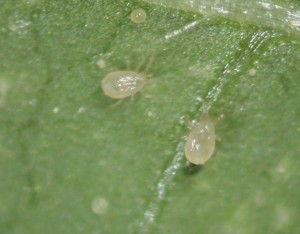Andersoni for Spider Mite Control
Description
 This predatory mite is beige in color and less than 1 mm in size. Amblyseius andersoni is a predatory mite which feeds on many types of small arthropod prey and pollen. It is widely reported as a predator of spider mites on fruit crops such as apples, peaches, grapes, and raspberries. This predatory mite eats many different pest mites such as spider mite, gall mite, and russet mite. Main target pests are spider mites (Tetranychus spp.), European (or citrus) red mite (Panonychus spp.) and Eriophyid mites, including the tomato rust (or russet) mite Aculops lycopersici.
This predatory mite is beige in color and less than 1 mm in size. Amblyseius andersoni is a predatory mite which feeds on many types of small arthropod prey and pollen. It is widely reported as a predator of spider mites on fruit crops such as apples, peaches, grapes, and raspberries. This predatory mite eats many different pest mites such as spider mite, gall mite, and russet mite. Main target pests are spider mites (Tetranychus spp.), European (or citrus) red mite (Panonychus spp.) and Eriophyid mites, including the tomato rust (or russet) mite Aculops lycopersici.
Lifestyle
Adult female mites lay single eggs onto leaf hairs, and these eggs hatch after 2-3 days into larvae. All mobile stages are predatory, and they will feed on eggs, juveniles and adults of spider mites. As temperatures decrease, and days become shorter, in early autumn the mites will enter into a diapause so they can successfully survive winter conditions. They are reported to become active again as early as January but that depends on temperatures and food availability.
Benefits
Amblyseius andersoni can be used indoors and outdoors on a wide range of host plants. They can treat many types of spider mite and other mite pests. They have a wide temperature tolerance of 43ºF – 104ºF. Amblyseius andersoni is reported to be one of the first predatory mites to invade fruit crops after insecticide treatments are reduced. These mites can also survive on young larvae of thrips, flower pollen, sugary excretions from pests, and fungi, so they can be introduced before the prey is present. They are available in loose shaker tubes and breeding sachets. The sachets are resistant to water so the breeding population of mites remain in good condition. The sachets can provide a release of mites over several weeks.
Drawbacks
Amblyseius andersoni is intended as a preventative treatment for spider mites and other mite pests. It is best used before pest populations have reached high levels.
Scouting
Uninfested and damage/webbing-free new growth is a good sign. So is empty webbing, in interiorscapes and some greenhouses, or missing webbing, outdoors (if it was there to begin with). Unless your scouting is really top-notch, you’ll probably miss most of the predators present on the leaves. However, if you see some agile-looking mites running quickly across the leaf’s undersurface, they are probably predators.
Advisories
For best results apply the A. andersoni when pest mite numbers are low. The predatory mites will then be able to feed on small colonies of pest mites and prevent them from growing and causing major damage. It is better to use A. andersoni together with other specialized predatory agents. Avoid exposing the sachets to direct sunlight.
Usages
This predator works well on both inside protected crops and outside in ornamental crops, fruit trees, horticulture, nurseries and seedbeds.
Release rates
Sachets: use one per every 6-10 Sq. feet of canopy
Shaker tube: 2 to 5 predatory mites per square feet
In trees: 1 sachet/tree
 This predatory mite is beige in color and less than 1 mm in size. Amblyseius andersoni is a predatory mite which feeds on many types of small arthropod prey and pollen. It is widely reported as a predator of spider mites on fruit crops such as apples, peaches, grapes, and raspberries. This predatory mite eats many different pest mites such as spider mite, gall mite, and russet mite. Main target pests are spider mites (Tetranychus spp.), European (or citrus) red mite (Panonychus spp.) and Eriophyid mites, including the tomato rust (or russet) mite Aculops lycopersici.
This predatory mite is beige in color and less than 1 mm in size. Amblyseius andersoni is a predatory mite which feeds on many types of small arthropod prey and pollen. It is widely reported as a predator of spider mites on fruit crops such as apples, peaches, grapes, and raspberries. This predatory mite eats many different pest mites such as spider mite, gall mite, and russet mite. Main target pests are spider mites (Tetranychus spp.), European (or citrus) red mite (Panonychus spp.) and Eriophyid mites, including the tomato rust (or russet) mite Aculops lycopersici.

